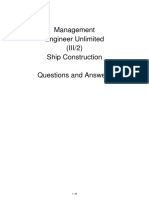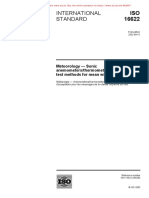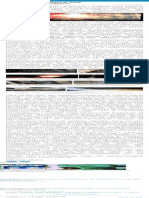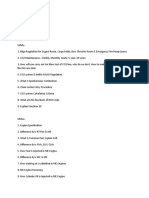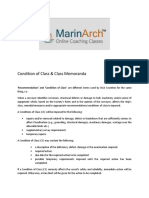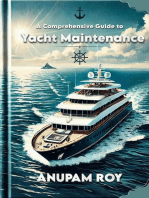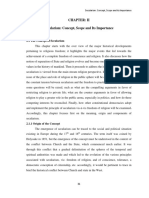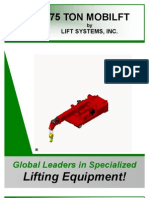0 ratings0% found this document useful (0 votes)
185 viewsRudder Repairs 19022020
Rudder Repairs 19022020
Uploaded by
ishaqThe document discusses inspection and repair of a ship's rudder. Key points include:
- Manual metal arc welding is suitable for rudder repairs, often requiring multi-position welding while drydocked.
- Inspections check for water ingress and measure bearing/clearances, with standard clearance values provided.
- Wear parts like the heel disk that connects the rudder and pintle should be renewed if too thin.
- The rudder carrier connecting the rudder to the steering gear is also important to inspect for cracks or loose bolts.
- Rudder components should be checked for deformations or fractures, especially around welds and connections.
Copyright:
© All Rights Reserved
Available Formats
Download as PPTX, PDF, TXT or read online from Scribd
Rudder Repairs 19022020
Rudder Repairs 19022020
Uploaded by
ishaq0 ratings0% found this document useful (0 votes)
185 views72 pagesThe document discusses inspection and repair of a ship's rudder. Key points include:
- Manual metal arc welding is suitable for rudder repairs, often requiring multi-position welding while drydocked.
- Inspections check for water ingress and measure bearing/clearances, with standard clearance values provided.
- Wear parts like the heel disk that connects the rudder and pintle should be renewed if too thin.
- The rudder carrier connecting the rudder to the steering gear is also important to inspect for cracks or loose bolts.
- Rudder components should be checked for deformations or fractures, especially around welds and connections.
Copyright
© © All Rights Reserved
Available Formats
PPTX, PDF, TXT or read online from Scribd
Share this document
Did you find this document useful?
Is this content inappropriate?
The document discusses inspection and repair of a ship's rudder. Key points include:
- Manual metal arc welding is suitable for rudder repairs, often requiring multi-position welding while drydocked.
- Inspections check for water ingress and measure bearing/clearances, with standard clearance values provided.
- Wear parts like the heel disk that connects the rudder and pintle should be renewed if too thin.
- The rudder carrier connecting the rudder to the steering gear is also important to inspect for cracks or loose bolts.
- Rudder components should be checked for deformations or fractures, especially around welds and connections.
Copyright:
© All Rights Reserved
Available Formats
Download as PPTX, PDF, TXT or read online from Scribd
Download as pptx, pdf, or txt
0 ratings0% found this document useful (0 votes)
185 views72 pagesRudder Repairs 19022020
Rudder Repairs 19022020
Uploaded by
ishaqThe document discusses inspection and repair of a ship's rudder. Key points include:
- Manual metal arc welding is suitable for rudder repairs, often requiring multi-position welding while drydocked.
- Inspections check for water ingress and measure bearing/clearances, with standard clearance values provided.
- Wear parts like the heel disk that connects the rudder and pintle should be renewed if too thin.
- The rudder carrier connecting the rudder to the steering gear is also important to inspect for cracks or loose bolts.
- Rudder components should be checked for deformations or fractures, especially around welds and connections.
Copyright:
© All Rights Reserved
Available Formats
Download as PPTX, PDF, TXT or read online from Scribd
Download as pptx, pdf, or txt
You are on page 1of 72
Rudder repairs for cl2
• The welding process most suitable for rudder
repair is MANUAL METAL ARC WELDING. ...
• It will probably be in-situ repair in Dry-dock
requiring multi-position welding (down hand,
overhead, horizontal, vertical).
• four welding types are used commonly, and they
are MIG, TIG, Stick and Flux- Cored arc welding.
Drydock inspection
• Detecting ingress of water into rudder
If we find some wet area in the rudder platet, it is
likely that cracks have occurred in the rudder plate
and sea water has ingressed.
• Even if water has entered into the rudder, only the
buoyancy of the rudder is lost and no major casualty
will occur.
• However, internal parts of the rudder might corrode,
therefore, the plug in the bottom plate of the rudder
should be opened and water should be drained out.
• Measurement and allowable values of bearing and
jumping clearances
Measurement of clearances of all bearings are to
be carried out during rudder inspection.
• Therefore, clearances of the sleeve and the bush in
the longitudinal direction (F ~ A) and the
transverse direction (P ~ S) of the rudder should
be measured.
• Standard Clearance
i) Pintle
For a newly built ship,
the standard clearance
is 1.5 mm.
For a ship in
service, Maximum
allowable clearances
between pintle and
bush is 6 mm.
IF the actual clearance
exceeeds 6mm, the bush
should be renewed.
Neck bearing
• The rudder is generally supported at three
points; In case o f a hanging rudder, the
supporting point is two.
• However, in rare cases, some ships have
rudders supported at four points, with an
additional intermediate bearing below the
uppermost support, namely the rudder carrier
• Clearance in the neck bearing can be measured
after the rudder is overhauled.
• Unless other wise the measurement is carried out
using a feeler gauge.
• The standard clearance is 4.0 mm,
• If the clearance exceeds 5.0mm, the bush should
be replaced.
• Actually the wear down of the neck bearing bush is
smaller than the pintle.
Jumping Clearance:
• the designed clearance is 2.0 mm maximum.
• There are no instances of damage or corrosion to
the jumping stopper itself.
• However, if the clearance measured is found to be
large, it can be concluded that the rudder has
moved down.
• The clearances can be taken from rudder trunk –
between the stopper and carrier bearing.
Wear to heel disk
• Generally two hard, semi-circular steel disk is fitted in the
shoe piece and the bottom of pintle, one above the other
so that a point contact is obtained; however, the upper
heel disk is sometimes part of the pintle.
• In this case, the lower part of the pintle is semi-circular.
This heel disk rotates together with the rudder and has a
box-shaped spigot.
• The semi-circular shape of the heel disk becomes flat
when it wears out, causing the rudder coming
downwards.
• If the heel disk becomes thin due to wear, it should be
renewed.
• The designed clearance between rudder bottom
and shoe piece is 20 mm to 30 mm.
• If the clearance is between 0 and 10 mm, the heel
disk should be renewed, or the rudder carrier
should be opened up and the surface of bearing
disk.
Rudder carrier
• Though there is no relationship to bottom
inspection, the rudder carrier is an important part
connecting the rudder and the steering gear in the
steering gear room.
• The points for inspecting the rudder carrier are
listed below.
(1) Looseness of bolts connecting rudder carrier to
deck are to be examined with the test hammer.
(2) Cracks in deck connection part
• In the construction shown in
the figure on the left, crack
will not apear in the deck.
• But in the figure right,
cracks might appear in the
welded joint at the inserted
liner to the deck. when the
thicker liner plate is welded
to deck.
• Sometimes
circumference cracks might
be appeared in the weld
joining to the deck
• (3) Looseness of wedge
Where reamer bolts are not used but a wedge is
used for securing the rudder carrier to the deck, if
the wedge becomes loose, or the direction in which
the wedge is driven is incorrect, the carrier might
turn; therefore, confirm that the wedge has been
secured correctly.
Deformations and Fractures
• Rudder blade, rudder stock, rudder horn and
propeller boss/brackets have to be checked for
deformations.
• Indications of deformation of rudder stock/rudder
horn could be found by excessive clearance.
• Possible twisting deformation or slipping of cone
connection can be observed by the difference in
angle between rudder and tiller.
• If bending or twisting deformation is found, the
rudder has to be dismounted for further inspection.
• welds of movable part to the rudder blade, and welds
of the access plate in case of vertical cone coupling
between rudder blade and rudder stock and/or pintle.
• Such welds may have latent defects due to the
limited applicable welding procedure.
• Serious fractures in rudder plating may cause loss of
rudder.
• Fractures should be looked for at weld connection
between rudder horn, Propeller boss and propeller
shaft brackets, and stern frame
Fractures should be looked for at the upper and lower corners
in way of the pintle recess in case of semi-spade rudders.
Sketch of the damage
• Fractures should be looked for at the transition
radius between rudder stock and horizontal
coupling (palm) plate, and the connection between
horizontal coupling plate and rudder blade in case
of horizontal coupling.
You might also like
- Chiefs Ship Cons Questions and Answers Oct 2020 and AugDocument69 pagesChiefs Ship Cons Questions and Answers Oct 2020 and AugSajeev NerurkarNo ratings yet
- Types of BottomDocument4 pagesTypes of BottomAnakin Skywalker100% (1)
- With Respect To Main Boiler Super Heater ArrangementsDocument2 pagesWith Respect To Main Boiler Super Heater ArrangementsAnakin Skywalker100% (1)
- Windlass NotesDocument2 pagesWindlass Notessbdman100% (3)
- Anemometro ISO - 16622 - EN PDFDocument11 pagesAnemometro ISO - 16622 - EN PDFfernando ochoaNo ratings yet
- Anchor Study MaterialDocument10 pagesAnchor Study MaterialSunil S I ShippingNo ratings yet
- Motor Solved Written Question AnswerDocument64 pagesMotor Solved Written Question Answerkum512No ratings yet
- EGBDocument5 pagesEGBSwarg VibhaNo ratings yet
- Derating of BoilerDocument1 pageDerating of BoilerAjim MokashiNo ratings yet
- A044 - Actions When Unable To Heave Up AnchorDocument4 pagesA044 - Actions When Unable To Heave Up Anchoranatoliy100% (2)
- Seaspan 3rd Engineer OralsDocument7 pagesSeaspan 3rd Engineer OralsVihanga VithanageNo ratings yet
- Chapter 7 Steering GearDocument80 pagesChapter 7 Steering GearHafizuddin Razak100% (3)
- Raising Steam From A Cold ConditionDocument3 pagesRaising Steam From A Cold ConditionbadpplNo ratings yet
- Understanding Conventions, Protocols & Amendments: International Maritime Organization (IMO)Document3 pagesUnderstanding Conventions, Protocols & Amendments: International Maritime Organization (IMO)sbdmanNo ratings yet
- Cy - Head 2strokeDocument33 pagesCy - Head 2strokeغازي عليNo ratings yet
- Port State Control 1 YearDocument11 pagesPort State Control 1 YearSidharth PrakashNo ratings yet
- Rudder Carrier WearDocument2 pagesRudder Carrier WearNAGENDRA KUMAR DNo ratings yet
- Stern TubeDocument79 pagesStern Tubenilakhan456790100% (1)
- Anchor Chain Cable PDFDocument19 pagesAnchor Chain Cable PDFKoldo Gómez AlzibarNo ratings yet
- Oil Contamination in Marine BoilerDocument2 pagesOil Contamination in Marine BoilerManish KhakhraNo ratings yet
- Example of Bunker ReportDocument2 pagesExample of Bunker ReportNunzioBest50% (2)
- Manometer Measuring TanksDocument4 pagesManometer Measuring TanksBouncer Bin100% (1)
- Ekg Class2Document46 pagesEkg Class2Anonymous 4ylE57C6No ratings yet
- Moulded and Displacement DimensionsDocument7 pagesMoulded and Displacement DimensionsHabibah Dwi SalmaNo ratings yet
- Section 3 - Oil To Sea Interface Log: Date: 1 - Jun - 2011 Fleet Management Ltd. Revision: 0 Revision: 0Document1 pageSection 3 - Oil To Sea Interface Log: Date: 1 - Jun - 2011 Fleet Management Ltd. Revision: 0 Revision: 0ravilullaNo ratings yet
- Sounding PipeDocument13 pagesSounding PipeSandeep KumarNo ratings yet
- NavalDocument18 pagesNavalRahul Ved0% (1)
- 15.1.1d Bulkheads 2Document14 pages15.1.1d Bulkheads 2vickyNo ratings yet
- Force On Crosshead GuidesDocument2 pagesForce On Crosshead GuidesNandakishore PradeepNo ratings yet
- Some Test About RuddersDocument2 pagesSome Test About RuddersVaibhav DesaiNo ratings yet
- Answer:-Repeat QuestionDocument13 pagesAnswer:-Repeat Questionsumitsinha89No ratings yet
- GL - Continuous Survey InstructionsDocument2 pagesGL - Continuous Survey Instructionshpss77No ratings yet
- DefDocument6 pagesDefMohammad Tushar BhuyanNo ratings yet
- Surveys For Maint'Ce ClassDocument7 pagesSurveys For Maint'Ce ClassSuhe EndraNo ratings yet
- Hsfo Lsmgo PDFDocument2 pagesHsfo Lsmgo PDFRajTiwariNo ratings yet
- Question 2Document9 pagesQuestion 2Yuva RajNo ratings yet
- Weekly Work Done - DeckDocument8 pagesWeekly Work Done - DeckGogiNo ratings yet
- In Water SurveyDocument33 pagesIn Water SurveyZin Maung Tun100% (1)
- Windlass Brake CapacityDocument2 pagesWindlass Brake CapacityDejone RabanesNo ratings yet
- MEP ME Crank Pin Bearing OHDocument30 pagesMEP ME Crank Pin Bearing OHSuhas KassaNo ratings yet
- How and Why To Take Manual Sounding On ShipDocument6 pagesHow and Why To Take Manual Sounding On ShipGiorgi Kandelaki100% (1)
- Noida MMD Viva QuestionsDocument61 pagesNoida MMD Viva QuestionsSameerFernandezNo ratings yet
- DG Set Repair Rate ContractDocument17 pagesDG Set Repair Rate Contractboobalan_shriNo ratings yet
- Crane SafetiesDocument38 pagesCrane SafetiesSamar Rustagi100% (1)
- Parametric Rolling - Container Lashing Systems: March 2002Document1 pageParametric Rolling - Container Lashing Systems: March 2002Dee CeeNo ratings yet
- Safety Meo Class 4Document18 pagesSafety Meo Class 4Bhargav Krsna GayanNo ratings yet
- Load Line SurveysDocument2 pagesLoad Line SurveysBharatiyulam100% (4)
- 8 Common Problems Found in ShipDocument3 pages8 Common Problems Found in ShipAnoop VijayakumarNo ratings yet
- SC 251 Controls of Emergency Bilge Suction Valve in Periodically Unattended Machinery Spaces (SOLAS Regulations II-1/48.3) SC 251Document1 pageSC 251 Controls of Emergency Bilge Suction Valve in Periodically Unattended Machinery Spaces (SOLAS Regulations II-1/48.3) SC 251Mr-SmithNo ratings yet
- Condition of ClassDocument2 pagesCondition of ClassFinito TheEndNo ratings yet
- Scav Manifold Inspection. PDFDocument2 pagesScav Manifold Inspection. PDFXahid HasanNo ratings yet
- Docking Survey Valve InspectionDocument9 pagesDocking Survey Valve InspectionFarihna JoseNo ratings yet
- Bale and Grain Capacity, Steel Coil LoadingDocument8 pagesBale and Grain Capacity, Steel Coil LoadingRobin100% (1)
- Continuous Machinery SurveyDocument7 pagesContinuous Machinery SurveyEko Prasetiyo100% (2)
- Shaft EarthingDocument3 pagesShaft EarthingPR WorldNo ratings yet
- Holds and Hatch Covers - Guide ClubDocument41 pagesHolds and Hatch Covers - Guide ClubCan T. Erbay100% (1)
- Installation Precautions of Rudder System-(Reference)Document5 pagesInstallation Precautions of Rudder System-(Reference)Raffaele PiccirilloNo ratings yet
- 1.10a - Crankshaft DeflectionsDocument5 pages1.10a - Crankshaft DeflectionsHeroNo ratings yet
- Fabrication and Inspection of PV and Columns PPMAIDocument47 pagesFabrication and Inspection of PV and Columns PPMAIguruj30576450% (2)
- PumpmaintenanceDocument35 pagesPumpmaintenanceAltamash TamboliNo ratings yet
- RMFADocument1 pageRMFAishaqNo ratings yet
- RaffDocument1 pageRaffishaqNo ratings yet
- RPSCRBDocument1 pageRPSCRBishaqNo ratings yet
- IB (03-21) - Safety Notices at Western AustraliaDocument28 pagesIB (03-21) - Safety Notices at Western AustraliaishaqNo ratings yet
- Re-Liq Plant Capacity Test ProcedureDocument10 pagesRe-Liq Plant Capacity Test ProcedureishaqNo ratings yet
- DG Circular Cyber Risk ManagementDocument3 pagesDG Circular Cyber Risk ManagementishaqNo ratings yet
- IB (84 20) AttachmentDocument3 pagesIB (84 20) AttachmentishaqNo ratings yet
- IB (83-20) - Attachment - Slings Encased in Plastic SheathingDocument3 pagesIB (83-20) - Attachment - Slings Encased in Plastic SheathingishaqNo ratings yet
- A Basic and Simple Guide of Civil Liability Convention 92Document6 pagesA Basic and Simple Guide of Civil Liability Convention 92ishaqNo ratings yet
- IB (83-20) - Risks of Lifting Slings Encased in Plastic Sheathing On Freefall LifeboatsDocument1 pageIB (83-20) - Risks of Lifting Slings Encased in Plastic Sheathing On Freefall LifeboatsishaqNo ratings yet
- F-33 (DCCM) V.04Document16 pagesF-33 (DCCM) V.04ishaqNo ratings yet
- Results of The Gas Carrier Reliquefaction Plant Trial: TransportDocument5 pagesResults of The Gas Carrier Reliquefaction Plant Trial: TransportishaqNo ratings yet
- Ultra-Thin Whitetopping (UTW) Project: UTW Thickness (MM) Joint Spacing (M) Fiber Concrete Plain ConcreteDocument3 pagesUltra-Thin Whitetopping (UTW) Project: UTW Thickness (MM) Joint Spacing (M) Fiber Concrete Plain ConcreteEric GironNo ratings yet
- ENVS ProjectDocument24 pagesENVS ProjectSwarup Dey ChowdhuryNo ratings yet
- IB Chemistry Online SAQ - Ans - 001 021 PDFDocument22 pagesIB Chemistry Online SAQ - Ans - 001 021 PDFVia PetitNo ratings yet
- Application SupportDocument2 pagesApplication Supportsivavadde150No ratings yet
- Calculate Cable Voltage Drop For Street Light PoleDocument3 pagesCalculate Cable Voltage Drop For Street Light PoleWaghNo ratings yet
- VSAT NetworksDocument28 pagesVSAT NetworksAhmad Salam AbdoulrasoolNo ratings yet
- Course Outline OPMG4230 - 2024Document4 pagesCourse Outline OPMG4230 - 2024Kevin ValaniNo ratings yet
- MaxiBAS BT506 User ManualDocument46 pagesMaxiBAS BT506 User ManualGeoDude51No ratings yet
- Cataract_Surgery_Advanced_Techniques_for_Complex_and_ComplicatedDocument517 pagesCataract_Surgery_Advanced_Techniques_for_Complex_and_ComplicatedMike VerveikoNo ratings yet
- OBESITYDocument3 pagesOBESITYfemeritusconsultNo ratings yet
- Regression AnalysisDocument7 pagesRegression AnalysisshoaibNo ratings yet
- Changing To Past Tense WorksheetsDocument11 pagesChanging To Past Tense Worksheetseas grade04100% (1)
- RKR Spring 2010 Recipe Book: Whipped CreamDocument38 pagesRKR Spring 2010 Recipe Book: Whipped Creamlookitschex100% (1)
- Secularism: Concept, Scope and Its ImportanceDocument33 pagesSecularism: Concept, Scope and Its ImportanceSubiNo ratings yet
- CPVC ChecklistDocument1 pageCPVC Checklistchakravarthi kanugulaNo ratings yet
- Electromagnetic Signals: Engr. Mark Jefferson A. Arellano, Ect, VCP, RtaDocument52 pagesElectromagnetic Signals: Engr. Mark Jefferson A. Arellano, Ect, VCP, RtaMark ArrelanoNo ratings yet
- 75 Ton Mobilift Specifications LiveDocument8 pages75 Ton Mobilift Specifications LiveGoldi LanjuNo ratings yet
- A4vso LRG PDFDocument1 pageA4vso LRG PDFHaytham ElbazNo ratings yet
- HVAC ValidationDocument58 pagesHVAC ValidationCOMPAQSR14No ratings yet
- 20190822.installation Manual For LONGi Solar PV Modules - CompressedDocument28 pages20190822.installation Manual For LONGi Solar PV Modules - CompressedFelipe Valdivia MorenoNo ratings yet
- Evaluation of Chondroitin Sulfate in Shark Cartilage Powder As A Dietary Supplement - Raw Materials and Finished Products-2007Document8 pagesEvaluation of Chondroitin Sulfate in Shark Cartilage Powder As A Dietary Supplement - Raw Materials and Finished Products-2007intel44444No ratings yet
- Perceptions About Penis Size Among Supposedly Healthy 40 To 60-Year-Old Brazilian Men: A Cross-Sectional Pilot StudyDocument7 pagesPerceptions About Penis Size Among Supposedly Healthy 40 To 60-Year-Old Brazilian Men: A Cross-Sectional Pilot Studyhamza shahNo ratings yet
- (Kelas 8) Soal PTS Bahasa Inggris Semester 1Document3 pages(Kelas 8) Soal PTS Bahasa Inggris Semester 1Ahmad Fikri Tajuddin SubkiNo ratings yet
- Linke Hofmann Busch Coaches (LHB) : ADARSH (14113004) AJAY SINGHAL (14113007)Document15 pagesLinke Hofmann Busch Coaches (LHB) : ADARSH (14113004) AJAY SINGHAL (14113007)Deepak MahawarNo ratings yet
- SymbolDocument4 pagesSymbolsisiner09 Dascălu0% (1)
- Session Seven Phonetics ExercisesDocument11 pagesSession Seven Phonetics ExercisesNur AsiahNo ratings yet
- RMS CAN Protocol (V4 - 3)Document52 pagesRMS CAN Protocol (V4 - 3)Collin KidderNo ratings yet
- Ultrasonic or MFL InspectionDocument4 pagesUltrasonic or MFL InspectionArjun Pratap Singh100% (3)
- P38 System - Abs, SRS, Hevac, Gearbox, Hella CCDocument16 pagesP38 System - Abs, SRS, Hevac, Gearbox, Hella CCandrianjaka27No ratings yet
